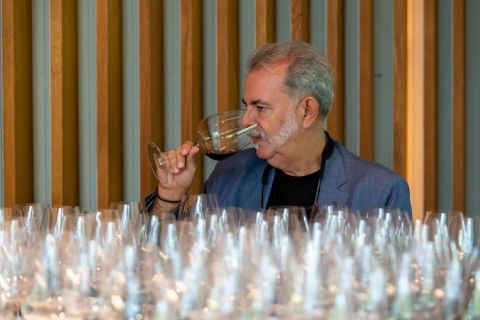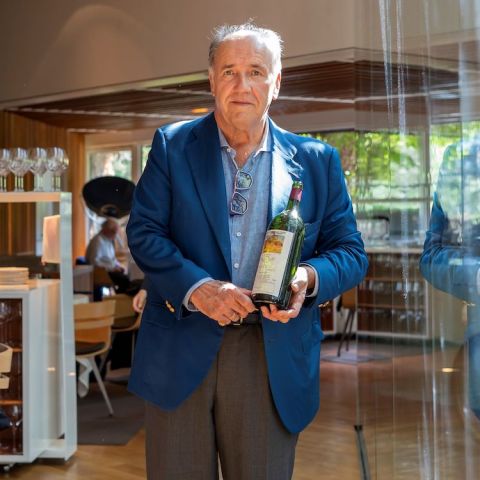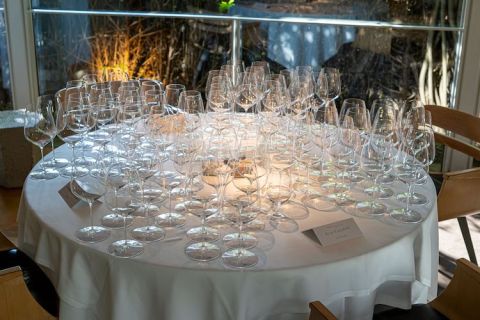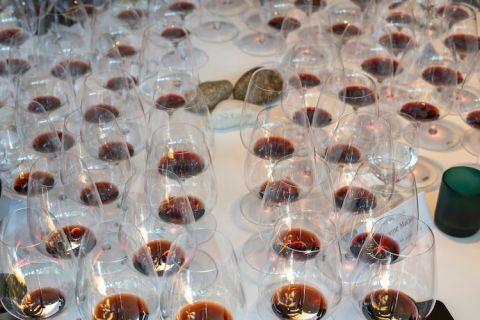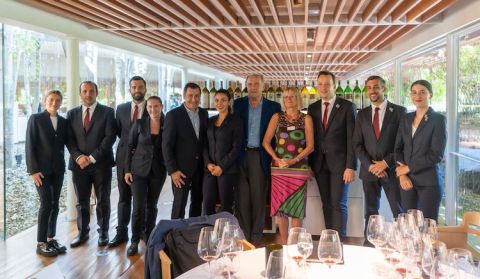My guess is that the average wine enthusiast most readily thinks of Cabernet Sauvignon as the grape variety that makes the longest-living reds in the world, though there might be the odd vote for Nebbiolo. But think again. Spain’s most-revered grape Tempranillo is very possibly the strongest candidate. You may see the name on supermarket bottles costing as little as £5 because Tempranillo dominates Spain’s red wine grapes with more than 40% (41% in 2020) of plantings. But the best examples can last for decades – arguably more decades than most red bordeaux.
My eyes were opened to the majesty and amazing longevity of the finest Tempranillo-based wines 11 years ago at a tasting organised by Spanish wine lovers Luis Gutiérrez and Jesús Barquín who brought over to the London flat of the editor of the World of Fine Wine Neil Beckett red riojas spanning 1982 back to 1945 (and some even older whites). Tempranillo has long provided the backbone of all but a handful of red riojas (although the Garnacha which plays a minor role in Rioja is enjoying a modest resurgence).
Most of the best of these old riojas were made by CVNE, Lopéz de Heredia, La Rioja Alta, and Marqués de Riscal, which still has famously copious stocks of its 1945. I wrote an article about this revelatory tasting entitled The most inspiring tasting ever and promptly appointed Gutiérrez the Spanish specialist on JancisRobinson.com, until he was poached by Robert Parker’s Wine Advocate. (El Bulli’s wine man Ferran Centelles has proved a very worthy substitute.)
I met up with Gutiérrez again, now sporting a Dali-eque moustache, earlier this month at an event that proved the Tempranillo-trumps-Cabernet thesis even more definitively. But before we got down to it he told me of another tasting, in Spain, that supported it. Apparently, after that old rioja tasting in London I’d said I’d love to compare fine red bordeaux with riojas of the same, very mature vintages. This planted the seed for an event held last November that I couldn’t in the end attend unfortunately: a tasting at Catalan fine-wine merchants Grau of a dazzling array of 1947s from both Bordeaux and Rioja. This is a wildly famous Bordeaux vintage, with Ch Cheval Blanc 1947 being acknowledged as one of the greatest wines of all time. Gutiérrez reported with glee that, although all of Bordeaux’s most famous 1947s were in the tasting, the wines that shone most brightly were two riojas. An account of this tasting has just been published on WineAdvocate.com.
The much more recent proof of Tempranillo’s superior ageing potential also took place in Catalunya, at world-famous El Celler de Can Roca restaurant in Girona. And this time the venerable Tempranillos were not from Rioja but from Spain’s other great red wine region, Ribera del Duero on the banks of the river known over the Portuguese border to the west as the Douro.
Pablo Álvarez, the reticent owner of the iconic (and for once that word is appropriate) Ribera del Duero, Vega Sicilia, wanted to celebrate 40 years of stewardship of this emblematic estate founded in the 1860s. Wine writers from all over the world were invited to the Roca brothers’ calm temple of creative gastronomy to taste all of the last 40 vintages of its most famous wine, Vega Sicilia Único.
And this was not just any collection of bottles amassed from cellars around the world. All wines were presented in magnums direct from the estate’s cellars, from the 2014 (to be released in bottle in 2024 and in magnum not until 2026) back to 1960. (No Único was made in 2001, 1997, 1993, 1992, 1988, 1984, 1978 and 1977 because the wine was not deemed good enough – so these are good years to head for Único’s less-expensive stablemate Valbuena 5°, into which the rejected wine will have been blended. The 2013 vintage of Valbuena 5° at £100, incidentally, retails for about a quarter of the price of a bottle of Vega Sicilia Único 2013.)
Vega Sicilia is exceptional not just for being the pioneer of a whole wine region, one currently scarred by unwise investment in showy bricks and mortar rather than the vines to supply the raw material for these bodegas. The story of the Álvarez family who acquired this ancient estate in 1982 has been one of constant investment and improvement in cellars and, especially, vineyards, but they have not dramatically changed the winemaking recipe. Vega Sicilia Único is still one of the longest-aged wines before release, typically at about 10 years old after alternating between many months in large, carefully maintained wooden vats, then in new or second-use barrels and then back in the large vats for a year or two before spending time in bottle. Ribera del Duero is basically a high plateau, its cool nights resulting in notable colour, acidity and tannins that need time to soften.
Only a really crack service team such as that managed by Josep Roca, the brother in charge of wine, could have managed to pour all these wines so seamlessly, almost invisibly, for 37 of us, seated at several round tables, with double chevrons of usefully vintage-labelled Riedel Cabernet/Merlot glasses at each place.
Seven sommeliers (pictured with Pablo, Josep and me below) and 17 waiters, I was told, ensured that all these wines and, with the second half of the tasting, nine incredibly inventive dishes from Joan and Jordi Roca’s kitchens, were in the right place at the right time so that we could concentrate on doing justice to the wines with our notes.
Since these wines were up to 60 years old, some disappointments were to be expected, but they were remarkably few. The estate had sent two magnums just to be sure and the back-up 1972 had to be opened because the cork let down the wine in the first one, and both magnums of 1968 opened in the morning session were rejected. The wine was, respectively, oxidised and corked.
Some measure of the attention to detail in the organisation of this event came towards the end of the afternoon session when a bottle of 1968 suddenly appeared. Apparently the Vega Sicilia team had rung round clients they thought might just be able to provide one and this bottle was solemnly driven 100 km (62 miles) from one of the Vila Viniteca wine shops in Barcelona to ensure that we did indeed taste exactly 40 vintages.
Most of the youngest vintages, impressive as they were, are far from ready. But the 2010 is already glorious, as is the 2004 (though in this particular vintage it does contain a high proportion (13%) of Cabernet along with the Tempranillo, known as Tinto Fino in Ribera del Duero) and the 2003 (less affected by that year’s heatwave than most French wines). Many of the wines made in the 1980s and 1990s are simply beautiful now, but the real stars that definitively outshone red bordeaux from the same vintages in their quality and – still – potential for further development were 1979, 1975, 1973, 1970 and an extraordinary 1965 that still has another 10 years to go, I reckon.
And the very longest-lived unfortified wines of any colour? My vote goes to Sauternes.
Recommended Tempranillo-based reds
Though I don’t guarantee that any of them will last 60 years…
Ayuso, Tanners Spanish Reserva 2017 La Mancha 13.5%
£9.95 Tanners
CVNE Reserva 2016 Rioja 14%
£13.95 ND John of Wales, £14.99 The Surrey Wine Cellar
Basconcillos, Viña Magna 2020 Ribera del Duero 14.5%
£14–£19 RRP
Tentenublo 2019 Rioja 14.5%
£17.95 Lea & Sandeman
Pujanza, Valdepoleo 2017 Rioja 14.5%
£18.21 (usually £23) Roberson
Contino Reserva 2017 Rioja 14%
Many stockists, from £18.69 de Burgh of Scotland, including £25 Tesco
Artuke, Finca de los Locos 2017 Rioja 14%
£21.67 Justerini & Brooks
Finca Allende 2014 Rioja 13.5%
£22.35 VINVM, £26.95 Wine & Greene
Lopéz de Heredia, Viña Bosconia Reserva 2010 Rioja 13.5%
£29.95 Wine & Greene, £33 Berry Bros & Rudd
Aalto 2018 Ribera del Duero 14.5%
£30 Focus Wines, £31.45 VINUM
Telmo Rodriguez, Lanzaga 2017 Rioja 14%
£31 Highbury Vintners
Tasting notes in our database. International stockists on Wine-Searcher.com.


